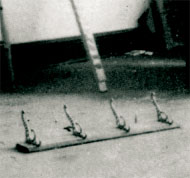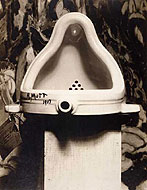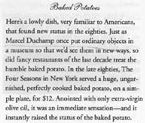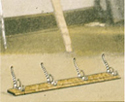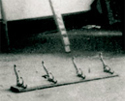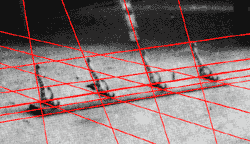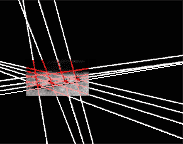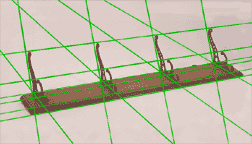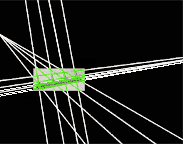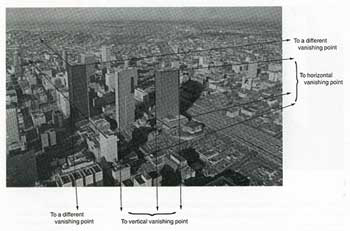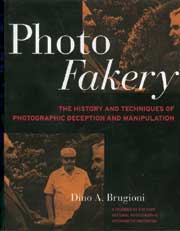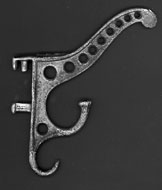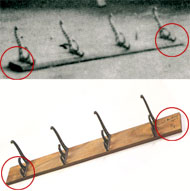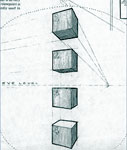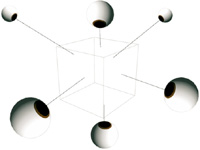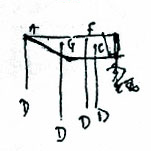|
page5
|
|
Why
the Hatrack is and/or is not Readymade: by Rhonda Roland Shearer with Gregory Alvarez, Robert Slawinski, Vittorio Marchi and text box by Stephen Jay Gould
<PART II> |
|||||||||||||||||||||||||||||||||||||||||||||||||||||||||||||||||||||||||
|
One, might think at this point, "So what. I can already see that Duchamp probably altered, physically or photographically, his readymade objects -- what difference does this make?" Let's set aside the fact that all books of art history or cultural criticism (and even cookbooks! See illustration 22C) state, as their premise, that Duchamp's readymades are unaltered, store bought mass-produced objects - and that this claim can now be dismissed as factually incorrect.(15) I will use illustrations 22A and 22B to show that Duchamp's original coatrack and urinal help explain why I believe Duchamp altered readymade objects in his photographs in the first place. Since the quality and approach that Duchamp used for his numerous distorted "readymade" representations are similar, such a frequency of occurrence suggests that Duchamp was applying a single geometric system. Perhaps this system that I have been observing throughout Duchamp's readymade works is the new and mathematically rigerous "rehabilitated perspective" geometry Duchamp spoke about in interviews. Moreover, I also found evidence that Duchamp used this new geometry in the Large Glass, just as he had claimed.
Let's look at the Coatrack (see illustration 23A, B, C, D, and E) as a series of snapshots in time, just as we did to examine Duchamp's hatracks, as he instructed us to do in his notes (refer again to illustration #1). Note that the geometries of the coatrack series (as we also found in the hatrack series), is different in every 2D and 3D representation. (For example, the iron hooks are straight in the 1964 Schwarz 3D model and 2D blueprint, whereas they lean backwards in the original 1916-17 studio photograph and in the 1941 Boîte print. And as in our treatment of the hatrack series, we must mentally visualize or, alternatively, make literal 3D models of the coatrack 2D representations, in order to observe the differences among all of the 5 coatrack representations (four 2D and one 3D). The particular distortions
contained within the original studio photograph provide the greatest
interest for our immeditate discussion. Again, as we found in the hatrack,
the coatrack hooks bend and turn in unanticipated ways. (We expect mass-produced
objects to have characteristics of the factory-made, traits that include
standardization and regularity of form -- the very opposite of custom-made
variations). Look at the last hook of the 4 (moving from left most hook
to right), the top small sub-hook (the middle of the three sub-hooks)
bends so far up and in that it reaches the top largest sub-hook. Duchamp
told us that he nailed the coatrack to the floor after having "kicked
it around" his studio. However, this trauma to the coatrack (that he
aptly titled "trap" or Trébuchet -- a term from a move in chess
where a player sacrifices one of his own pieces to trap an opponent's
piece) the physical properties of cast iron determine that such a hook
would crack and break before bending. This rigidity of material proves
useful for withstanding the stress of hanging heavy coats. Duchamp,
on the 1964 blueprint, even specifies that his 3D 1964 Schwarz hooks
must be made of iron -- not soft copper.
Note the shapes and count the holes in hook 24A and 24B and contrast these to the general form and number of holes found in Duchamp's original Coatrack hooks in the studio photo and in the Schwarz model in 24C
In fact, when Robert Slawinski and I began working on creating a coatrack 3D computer model (equivalent to the information contained in the 1915-16 2D studio photograph) we quickly recognized that the hooks used by Duchamp were; a) a common type readily found in the historical record (see illustrations 24 A and B); b.) that his 3D Schwarz model of the coatrack looked nothing like the "original coatrack" found in the studio photograph of 1915-16 (for example, note that the hooks are straighter in the 3D model and that the wood board bottom extends too far past the hooks on each end in comparison to what we find in the original 1915-16 2D studio photograph, see illustration 24; c) not only is the last hook (moving from right to left) distorted in the original studio photo above (in 24C) (its top small sub-hook with an impossible upward curve), but the other 3 main hooks of the four, and the wood board itself, are also distorted. In other words, we cannot take the matching historical hooks (as in illustration 24B), place them evenly on a symmetrically rectangular wood board and then find one single perspective viewpoint to make a projection that matches all the shapes of the coatrack, as Duchamp has depicted them in the original studio photograph (see illustration 23A).
See illustration 25 showing how the cube's shape changes according to the position of the viewer's eye position. When we know the original shape -- such as a cube or a series of identical coat hooks in a row -- we can then accurately predict what the shape of the cube or coat hooks will be from various observer's eye positions. In other words, if the resulting cube or coatrack shapes follow our predictions (based upon both our prior experience and perspective rules), then we say that the representation is "correct" (in perspective geometry); if the cube and coathook shapes are not in accordance with our predictions, then we say that the representation is distorted.
Illustration 25A depicts
the perspective found in photography -- one fixed eye sees a continuous
and related set of distortions from the perspective of this one eye.
(The four different cube descriptions in 25A are what the eye sees from
4 different fixed positions). Illustration 25B, however, more accurately
depicts how we actually see objects, as our two eyes, head and bodies
must continually move around 3D objects to fully see their forms, as
shown with this cube. And yet, despite what must be the truly fragmented
nature of the visual input, the mind and eyes work seamlessly together
to create the appearance of discrete and fixed objects. The two cube examples
(25A and B) directly relate to the earlier discussion of Duchamp's White
Box note, which, as I argued, describes 2 mental operations (see
illustration 26A and B). The single fixed eye perspective of 26A is
like the fixed eye looking at the cube in 25A; whereas the moving eye
of 26B operates like the multiple perspectives described in 25B. The notable difference
between illustrations 25A,B and 26 A,B is the dimension. Using Duchamp's
terminology, 25A,B describes an eye in 3D space ("eye3")
looking at a 3D cube; whereas, 26A,B represents an eye in 3D space making
observations of a 2D plane. Both 25B and 26B require time and movement
in 3D space of the 3D eye ; whereas, 25A and 26A illustrate what Duchamp
describes as the "vision" of the "same eye from a fixed
point of view (linear perspective)."1 |
|||||||||||||||||||||||||||||||||||||||||||||||||||||||||||||||||||||||||
